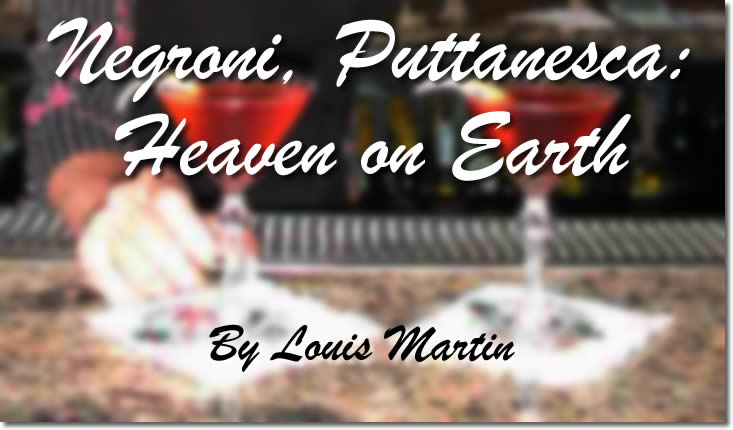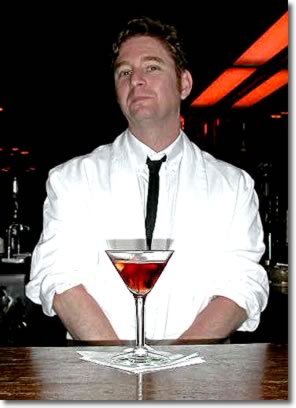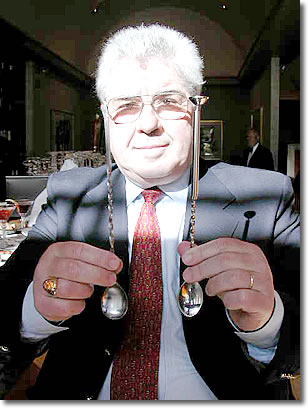Home | City Notes | Restaurant Guide | Galleries | Site Map | Search | Contact

I was hanging out at Tosca's a few weeks back when it struck me to ask Richard, the bartender, what his favorite drink was. I was expecting a moment's silence, a little mental searching, but his answer came without hesitation:
 "Negroni,"
he said.
"Negroni,"
he said.
Now one of the little stories about the Negroni is that it makes you decisive. So maybe that was the Negroni kicking in. I am—or was, I should say—a Martini guy and had never heard of the drink.
"Let's talk about this drink in a week or so," I said. It was Friday and Tosca's was filling up with that young crowd of professionals just getting off of work downtown. You see them on Fridays, never during the week.
"There's one with your name on it," said Richard.
It was a dark in Tosca's when I came back on a slow Thursday afternoon. The rich brown tones of the woodwork seemed to be glowing with soft light. There was only Richard, a couple of customers midway along the bar, and Jeannette, the owner, down at the end of the bar smoking a cigarette and wearing that wonderfully stubborn look of hers. The time was right to talk Negroni.
I asked Richard what he liked about the drink. He had been making them for awhile before he got into drinking them himself.
"They look good, they smell good," he said, "and I decided to see if they would taste good." They did. "They are fresh, tasty, and very drinkable."
The Negroni is an aperitif, an "opener," and Richard uses the classic proportions for this drink—equal parts Campari, gin, and sweet Vermouth. And although it can be made with dry Vermouth to make it less sweet for those who do not like sweet drinks, says Richard: "I think the sweetness of the Vermouth should balance out the astringency of the gin and the bitterness of the Campari." The drink can also be made with vodka instead of gin.
It is the Campari that is the medicinal "bitter" and provides the characteristic flavor of the drink. Compari was concocted by Gaspare Campari in the 1850s. Gaspare, at only age 14, was the master drink maker at the Bass Bar in Turin, which was the commercial center for aperitifs at the time. Campari is made with natural ingredients that include herbs, spices, bark and fruit peels. The exact formula is of course a highly guarded secret.
Richard also believes in serving the Negroni very cold. He shakes it like a Martini until his hands feel cold, then pours it "straight up" into a chilled cocktail glass. A little layer of ice floats upon the top. "You can almost skate on it," he says.
There are various stories about how the drink began. One has it that Count Camillo Negroni, a Florentine aristocrat, decided one day to add some bite to his favorite drink, the Americano. He had the bartender add gin. From that time on he ordered the same drink every day. Eventually the bartender named the drink after him. And others tried the drink and fell in love with it.
I asked Richard if you could go
on a binge on this drink, a reasonable question in San Francisco but one
that might be frowned upon elsewhere. He assured me it was a good binge
drink. Strange that Jack Kerouac never mentions it in one of his books.
He loved to binge drink in the City.
It is lively at Enrico's when I arrive. The light is brighter, and the yellow and white interior colors are uplifting. There are young couples at the bar chatting it up. If you are feeling blue when you arrive at Enrico's, chances are, unless it is a serious case of depression, you will be leaving with a smile on your face.
 Says
head bartender Dave Nepove, a man of great enthusiasm in everything he
does, "I love the Negroni. It is a classic, old-school cocktail."
He has been serving it for 18 years, and he says the Negroni will never
die.
Says
head bartender Dave Nepove, a man of great enthusiasm in everything he
does, "I love the Negroni. It is a classic, old-school cocktail."
He has been serving it for 18 years, and he says the Negroni will never
die.
Campari can be drunk in various ways, even by itself, and it is the Campari, says Dave, that "gets the stomach juices flowing, the taste buds moving ... it's a great before-dinner drink."
He says the two most popular Campari drinks are Compari and soda and the Negroni. But he warns that with gin and Vermouth, the Negroni has a "unique flavor that is not for everyone."
As mentioned above, not everyone likes the sweetness of the drink. Dave says he himself has never served it any other way than with sweet Vermouth. Like Richard at Tosca's, he believes the drink should be made that way. But he says that Marco, one of his other bartenders, changes the ratio of Campari, gin and sweet Vermouth. "That," says Dave, "is one way to lower the sweetness." Marco uses more gin and a lot less Vermouth (3 parts gin, 2 parts Campari, 1 part sweet Vermouth).
About binge-drinking of Compari, Dave says he does have a few customers who come in and order as many as five. "Usually it is Campari and soda or Campari and orange juice."
A few days earlier I had tried
Marco's Negroni, served in a big blue-tinged cocktail glass with double twists
of orange peel floating across the top. If there is a special cocktail lounge
for San Franciscan's in Heaven, surely the Negroni is served this way there.
It is about 5 on Friday when I go into North Beach Restaurant on Stockton near the Columbus. It is just starting to get busy. Martini glasses sit upside down on ice behind the bar and the late afternoon sun pours though the high windows at the entrance of the Tuscan-style restaurant.
 Bui,
the maitre d', says owner Lorenzo will be in about 5:30. I sit down at
the bar and Marilyn the bartender mixes me two Negronis—one made
with gin, the other with vodka. She says she has never had anyone ask
for dry Vermouth, but she has had requests for substituting vodka for
gin. I taste-test the two versions and there is no doubt in my mind: gin
is the right ingredient for this drink. The addition of the gin, with
its juniper-berry taste, brings to perfection the great flavor of Campari
and Vermouth. By comparison, the vodka version of this drink seems lacking.
Now if I had never had the drink with gin, I would probably love it with
vodka. Drink it with gin, however, and you won't want it any other way.
Bui,
the maitre d', says owner Lorenzo will be in about 5:30. I sit down at
the bar and Marilyn the bartender mixes me two Negronis—one made
with gin, the other with vodka. She says she has never had anyone ask
for dry Vermouth, but she has had requests for substituting vodka for
gin. I taste-test the two versions and there is no doubt in my mind: gin
is the right ingredient for this drink. The addition of the gin, with
its juniper-berry taste, brings to perfection the great flavor of Campari
and Vermouth. By comparison, the vodka version of this drink seems lacking.
Now if I had never had the drink with gin, I would probably love it with
vodka. Drink it with gin, however, and you won't want it any other way.
A tourist bus pulls up out front, and a small group of tourists streams out and is herded down to the basement. North Beach Restaurant get the business of all kinds: dedicated local dinners, out-of-towners, and tourists. It is one of the mayor's favorite places. He dines there two or three days a week, usually alone and late.
Lorenzo has now arrived and joins me at the bar.
It turns out the Negroni is his favorite drink. "That is all I drink," he says.
He also proudly points out that it is an Italian drink. His formula calls for 35% gin, 35% Campari, and 30% sweet Vermouth. That ratio probably helps keep the sweetness in balance. But he says the secret is this: "The Negroni has to be well mixed."
 This
brings up an age-old controversy: shaking versus mixing. I prefer to keep
a little distance from this, knowing that it will probably never be resolved
in my life time and not wishing to offend anyone anywhere who serves me
drinks in a bar. I will only point out that there are good arguments on
both sides. God will have to be the final judge on this one.
This
brings up an age-old controversy: shaking versus mixing. I prefer to keep
a little distance from this, knowing that it will probably never be resolved
in my life time and not wishing to offend anyone anywhere who serves me
drinks in a bar. I will only point out that there are good arguments on
both sides. God will have to be the final judge on this one.
"It is important," say Lorenzo, "not to bruise the gin and not to bruise the Campari. You have to very gently mix it."
He demonstrates the proper way to stir the gin and Campari, then I give it a try.
"No," says Lorenzo, "clockwise."
In order to stir properly, Lorenzo has had a special barspoon manufactured. (See photo below.) With the addition of a cylindrical tube around the stem of the spoon, the spoon is able to rotate in the ice and avoid, presumably, doing damage to the gin and Campari. Lorenzo points out that the fitting is loose, so that the spoon can be washed. While this might seem extreme to some, the result speaks for itself. The product is quite excellent, as is the food at this classic North Beach restaurant. It is also devoid of the little bubbles that shaking produces. But again, some like bubble and some don't. The North Beach Restaurant Negroni is a clearer, gentler product, like a little pool of chilled spring water that you might come across in high mountains country.
 For
the original Negroni, the rim of the glass was coated with sugar, say
Lorenzo. "But we don't do that any longer; they lost the practice."
It can also be served over ice, though most now serve it "up"
in a cocktail glass.
For
the original Negroni, the rim of the glass was coated with sugar, say
Lorenzo. "But we don't do that any longer; they lost the practice."
It can also be served over ice, though most now serve it "up"
in a cocktail glass.
"I drink it both ways," says Lorenzo laughing, "just to have to drink more."
I mention the story about Camillo Negroni adding gin to the Americano, but Lorenzo does not exactly buy it. "That sound very good," he says but says there are "many, many" versions of the story. The version he subscribes to is this:
"Negroni was invented by an American in Italy, and he mixed the Martini with the Campari. Instead of using Vermouth, he used the Campari. But this was too strong for the Italians so they modified it."
A nice story but too simple for my taste buds. I prefer the one about count ordering the same drink every day until they named the drink after him. That sounds like a lot more fun.
I notice two curious items on the menu which I have not seen before, and I ask Lorenzo about them: Pasta Puttanesca and Pasta Arrabiata.
"Arrabiata means 'angry' pasta; it is supposed to very hot and spicy." The other translates as "prostitute pasta." Both of these pastas are very famous in Italy, he says. "Maybe the puttanesca was made for prostitutes," he says laughing.
As it turn out, stories abound about food as well as drinks. One legend has it that pasta puttanesca was made at the end of the evening when the girls were all done with business. All the leftovers where thrown into the pot and it was served up with pasta. Another story has it that prostitutes made it themselves to attract customers with it strong, savory smell. I subscribe to either one of those stories, depending on my mood.
I decide to give "puttanesca"
a try. At North Beach Restaurant it comes in a tomato sauce with capers,
peas, and bits of olives. It is indeed savory. I polish this off with
Marilyn's two Negronis, and for some reason I start thinking about the
Hungry i down the street on Lower Broadway. I guess I'm ready for something
a little earthy after all this speculative stuff about the history of
a drink and the proper way to make it.
 It
is about 6 when I get to the Hungry i. The lovely Sunday works
there as bartender, and I think I'll go in and bore her with all I know
about the Negroni. But the lovely Sunday is not there; it turns out her
schedule has changed. And it is a very quiet start of an evening at the
Hungry i. Apparently there is a game in progress and the "guys"
are busy with that. There are six strippers, a bartender, a bouncer, a
sound man—and me. One stripper dances and the rest are at the bar.
I buy them all drinks. They become attentive. I'm their "customer."
For one brief moment in time I am the center of the universe. I'm in Heaven
on earth, though not the "on earth as it is in Heaven" that
the bible talks about. I come out of it and find out Sunday's schedule.
It
is about 6 when I get to the Hungry i. The lovely Sunday works
there as bartender, and I think I'll go in and bore her with all I know
about the Negroni. But the lovely Sunday is not there; it turns out her
schedule has changed. And it is a very quiet start of an evening at the
Hungry i. Apparently there is a game in progress and the "guys"
are busy with that. There are six strippers, a bartender, a bouncer, a
sound man—and me. One stripper dances and the rest are at the bar.
I buy them all drinks. They become attentive. I'm their "customer."
For one brief moment in time I am the center of the universe. I'm in Heaven
on earth, though not the "on earth as it is in Heaven" that
the bible talks about. I come out of it and find out Sunday's schedule.
 A
couple days latter I'm back at the Hungry i to see Sunday—she is
in fact my excuse for going there—and I order you-know-what. It comes
the old way, with the rim of the glass sugarcoated. Sunday is not much
of a drinker. In fact the last time she had a drink—a mudslide on
a skiing trip—she fell off the sky lift. But she smells the Negroni
that she has just made and offers this comment: "It is very summer-like
and has a hint of citrus."
A
couple days latter I'm back at the Hungry i to see Sunday—she is
in fact my excuse for going there—and I order you-know-what. It comes
the old way, with the rim of the glass sugarcoated. Sunday is not much
of a drinker. In fact the last time she had a drink—a mudslide on
a skiing trip—she fell off the sky lift. But she smells the Negroni
that she has just made and offers this comment: "It is very summer-like
and has a hint of citrus."
I ask her, "If you were a drinker, do you think you would like it?"
"Definitely," she says. "That is all I would drink... but prostitute pasta? How could they do that?"
If you prefer pool tables and swearing to naked girls and loud music, go down the street to the Crowbar. Sage, a master of improvisation when it comes to bartending—she can make your favorite drink without having any of the ingredients at all—will mix you a damn good one.
Home | City Notes | Restaurant Guide | Galleries | Site Map | Search | Contact